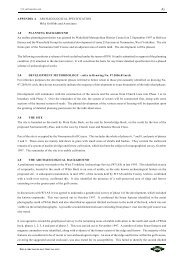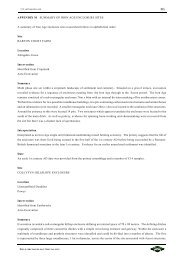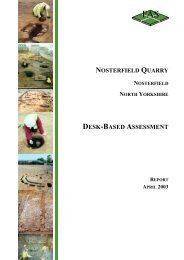ARCHAEOLOGICAL EVALUATION - Mike Griffiths and Associates
ARCHAEOLOGICAL EVALUATION - Mike Griffiths and Associates
ARCHAEOLOGICAL EVALUATION - Mike Griffiths and Associates
You also want an ePaper? Increase the reach of your titles
YUMPU automatically turns print PDFs into web optimized ePapers that Google loves.
FAS_lbf01.wpd 135<br />
at the eastern end. The yellowish-brown gravel <strong>and</strong> clayey silt<br />
ploughsoil (C1123) was found to be c.0.30-0.35m deep. This<br />
overlay the natural subsoil which consisted of an homogenous<br />
orangish-brown gravel <strong>and</strong> clayey silt which became gradually<br />
more grey in colour towards the eastern end of the trench<br />
(C1124).<br />
A single feature was identified within Intervention 31 <strong>and</strong><br />
allocated F33, which appeared as a crescentic deposit of light<br />
olive brown s<strong>and</strong>y clay (Figure 84). The deposit measured<br />
2.20m in length by 0.60m in width. Upon excavation, F33<br />
Plate 38 Intervention 31 looking east (scale<br />
2m)<br />
proved to have a shallow cut with gently sloping sides <strong>and</strong> a concave base <strong>and</strong> measured c.0.10m deep (Figure<br />
85). The feature had been backfilled once with C1221. The backfill consisted of a sterile pale olive s<strong>and</strong> with<br />
only rare mixed pebble inclusions <strong>and</strong> very rare charcoal flecks. F33 was interpreted as a small irregular pit;<br />
no dateable material was recovered during excavation.<br />
8.2.26 Intervention 32<br />
Intervention 32 was located in the southwestern corner of Zone<br />
A <strong>and</strong> measured 100m x 4m (see Figure 36). The trench was<br />
positioned in order to contact a curvilinear anomaly detected<br />
during the magnetometer area survey (Intervention 4, F13),<br />
although it was not encountered archaeologically. The trench<br />
was machine excavated <strong>and</strong> was orientated east-west (Plate 39).<br />
The ground within the area of the trench was 40.80m AOD.<br />
The yellowish-brown gravel <strong>and</strong> clayey silt ploughsoil (C1123)<br />
was found to be c.0.30m deep <strong>and</strong> overlay a natural subsoil<br />
which consisted of an homogenous orangish-brown gravel <strong>and</strong><br />
clayey silt with broad b<strong>and</strong>s of cleaner greyish-brown clayey<br />
silt towards the western end of the trench (C1124).<br />
Plate 39 Intervention 32 looking west (scale<br />
2m)<br />
No features were defined within Intervention 32.<br />
8.2.27 Intervention 33<br />
Intervention 33 was situated 29.20m to the north of Intervention<br />
33, measured 100m x 4m <strong>and</strong> was designed to investigate <strong>and</strong><br />
intersect several geophysical anomalies (Intervention 4, part of<br />
F7, F8 <strong>and</strong> F10, Intervention 5, F37) (see Figure 36). The<br />
trench was machine-excavated <strong>and</strong> was orientated north-south<br />
(Plate 40). Ground surface within the area of the trench was<br />
40.90m AOD. Ploughsoil consisted of a yellowish-brown<br />
gravel <strong>and</strong> clayey silt (C1123) which was a consistent 0.30-<br />
Plate 40 Intervention 33 looking north (scale<br />
2m)<br />
FIELD ARCHAEOLOGY SPECIALISTS







